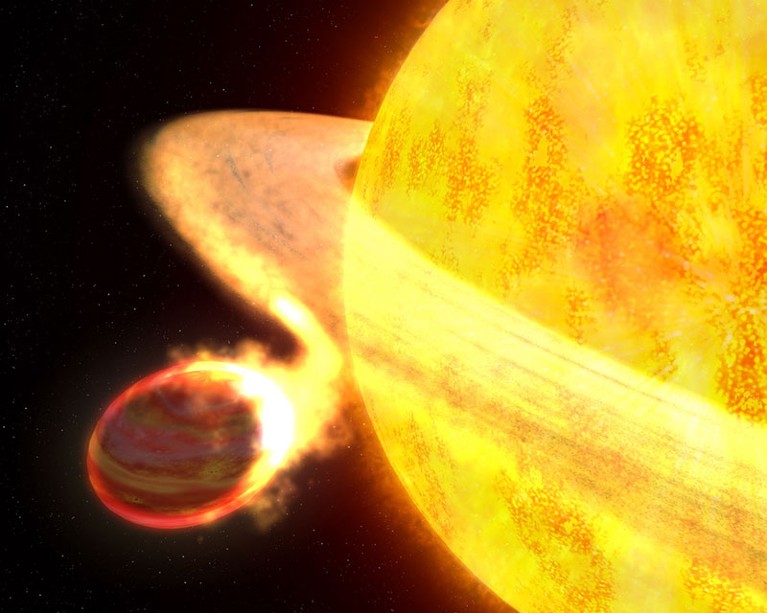
A star in the process of consuming a planet (artist’s conception).Credit: NG Images/Alamy
Stellar detectives have identified seven stars that recently dined on a rocky planet. The study doubles the number of binary stars known to have consumed a planet, and questions the perception that mature solar systems harbouring Earth-like planets are usually stable.
The findings, published in Nature on 20 March1, show “strong evidence of planet ingestion”, says Jianrong Shi, an astronomer at the National Astronomical Observatories in Beijing. The planets seem to have been eaten during their stars’ relatively stable main-sequence period, adds study co-author Fan Liu, an astronomer at Monash University in Melbourne, Australia.
If this is true, it means these systems have continued to be chaotic long after their formation, with planets disintegrating or falling into their star, says Johanna Teske, an astronomer at the Carnegie Institution for Science in Washington DC. “It’s an inference at this point. We need to look at these systems in more detail,” she says.
Swallowed by stars
Table of Contents
Last year, for the first time, astronomers observed a star in the process of eating a planet. But unravelling whether a star has done so in the past is challenging, because planets are tiny compared with their hosts, and their contents soon get diluted.
Different elements absorb and emit light of different wavelengths, so the composition of a star’s surface leaves a fingerprint on the light reaching Earth. But detecting whether a star has eaten a planet is similar to spotting a chocolate chip that’s been swirled into a bowl of vanilla ice cream, says Teske. Stars also vary a lot in their make-up, making it tough to prove that a star has a particular composition because it ingested a planet.

The 2,000 stars where aliens would catch a glimpse of Earth
To hunt for planet-eating stars, Liu and his colleagues performed a cosmic-twin study. Using the Gaia space telescope, they found 91 pairs of Sun-like stars nearby in the Milky Way, whose motions suggested that they were both born in the same gas cloud. The stars in such paired systems should have near-identical compositions and their similar lives should rule out many potential causes for discrepancies.
The team then used three ground-based telescopes to study the abundance of 21 elements in the pairs. If there were notable differences between a pair of stars, the researchers looked at whether this could be explained through noise in the data or other sources of variation. For seven pairs, “the difference has to be explained by one [star] ingesting a planet and the other not”, says Meridith Joyce, an astrophysicist at the Konkoly Observatory in Budapest, and a co-author on the paper.
Secret planet-eaters
The study suggests that around 8% of Sun-like star pairs in our region of the Milky Way harbour a planet-eater, says Liu. He adds that this estimate is conservative, because the team considered only stars ingesting rocky planets, whereas other stars might have eaten gaseous Jupiter- or Neptune-like bodies. The method would also have missed cases in which both stars had eaten a planet of similar composition.
Finding clear signs of planet ingestion in billion-year-old stars is “something unexpected”, he says. Astronomers often consider planet-eating to be a feature of a star’s early life, when planetary orbits are unstable and collisions are probable. But these meals must have been relatively recent, in the last few hundred millions of years, or theory suggests the evidence would’ve been undetectable, says Liu. The planets could have met their fate when their eroding atmospheres caused them to spiral inward, or some stars might have captured untethered rogue planets as they flew by, he adds.
Shi says that astronomers should examine these systems to see if any sibling exoplanets remain. The findings should make Earth-dwellers grateful, he says. The diversity of exoplanets has continued to shock astronomers; now it seems that “our Solar System is not only unique, but also undoubtedly peaceful”.
